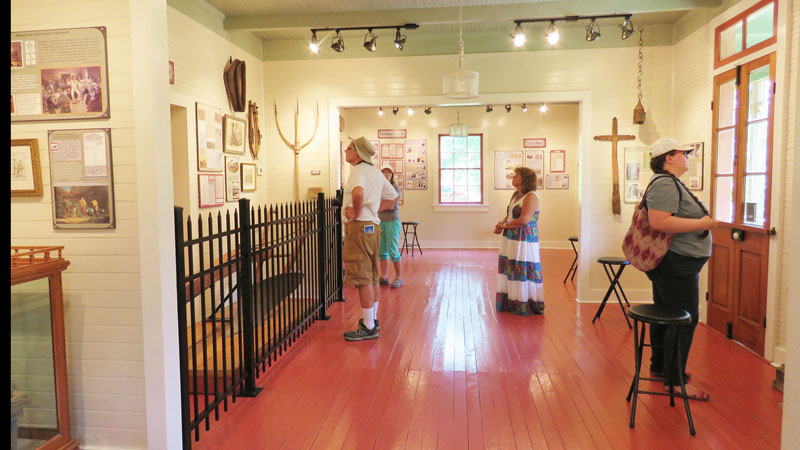The Laura Plantation story: Vacherie landmark telling detailed slave history
Published 12:04 am Saturday, August 5, 2017

- Visitors to Laura Plantation in Vacherie review the River Road attraction’s latest exhibit, a detailed account of the men and women who worked as slaves at the 200-year-old home and grounds.
VACHERIE — Since opening to the public in 1994, the owners of Laura Plantation have never shied away from its history of slavery.
The thousands of visitors to the former working sugar plantation have always heard an honest story of the people who lived and worked there, including the hundreds of slaves and their roles on the farm.
Trending
“Visitors come here with a very blurry view of slavery,” said Sand Marmillion, who bought the centuries old River Road plantation with her husband, Norman in 1993. “We have always tried to present a fair and balanced picture of the history here, and that included slavery. We had always talked about the slaves here ”
The Marmillions knew all about the Duparc family, which built the Creole-style raised house, and the Locoul family, which later owned the sugar business. Various documents on hand also provided a little information about the slaves.
After an electrical fire nearly destroyed the more than 200-year-old home and wiped out years of research documents, Sand began trying to reconstruct the database that had been built. This time, however, she wanted things to be different.

Sand Marmillion and Katy Shannon worked to turn a few first names of the slaves mentioned in memoirs into the most complete account possible of the men and women who worked there.
“My background is in cultural anthropology, so my approach was based on this academic training,” she said. “I didn’t want just a bunch of folders with documents, I wanted it to be databases. I wanted to know who were all the people who lived and worked here and how did they fit into the community.”
Sand and her collaborator, Katy Shannon, started with crumbs, little more than a few first names of the slaves mentioned in Laura Locoul Gore’s memoirs and some crumbling documents from the former sugar company and the deaths of the former owners.
“The community property laws and forced heirship laws in Louisiana really help when you’re doing research because you have to list everything,” Sand said. “Property owners leave this massive paper trail.”
Trending
Over the last decade and more, Sand followed those paper trails until she amassed an incredible amount of knowledge about the slaves of Laura Plantation, who they were, what they did and what happened to them and their families after the Civil War.
“We were able to find their origins and then see what happens to them over time,” she said. “We began to understand what were the jobs on the plantation. Now remember, I’m not looking at a timeline, I’m looking at a community.”

In “The Red Room” dozens of slave bills of sale are mounted on red backgrounds, along with several newspaper advertisements and handbills offering rewards for runaway slaves.
The result is a stunning exhibit titled, “From the Big House to the Quarters: Slavery on Laura Plantation,” which tells a rich story of the enslaved people who lived there and even reaches toward their descendants who are still in the area.
The exhibit, which includes everything from a large collection of tools to mundane household items, photographs and documents, is divided into themes: domestic life, family, health, religion, skilled labor, the field, runaways, the Civil War, Reconstruction and the slave trade.
The most moving section is what Sand calls “The Red Room,” which contains dozens of copies of actual bills of sale for hundreds of human beings along with advertisements offering rewards for runaways, each mounted on a red background.
“This is human trafficking,” Sand said.
The permanent exhibit opened in February in one of the 12 original buildings listed on the National Register of Historic Places.
Visitors also can tour the bright red and yellow big house, which is filled with antiques, some donated by descendants of the original families, slave cabins, overseer’s cottages.
Sand hopes the exhibit will offer a truer picture of slavery and, specifically, those who lived, worked and died at Laura Plantation.
“A lot of our visitors want to ask us very broad questions,” Sand said. “We don’t want to give broad answers. We want to give very specific answers. Who were these people and what were their jobs? What were they doing on this property? There were hundreds of people who lived and worked here and they were not a broad, unknown group of individuals. They were real people.”
The Plantation Store ticket office opens at 9:30 a.m. for guided tours only. The approximately 75-minute tours begin at 10 a.m. The last tour begins at 4 p.m.
Tickets are $20 for adults, $6 for children ages 6-17. Children 5-under are admitted free. Reservations are available for groups of 20 or more.
Call 225-265-7690 for more information or visit
lauraplantation.com.






